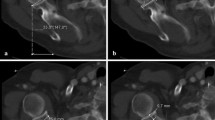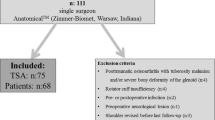Abstract
Purpose
Reduced bone stock and difficult intraoperative orientation are challenges in glenoid replacement surgery. New implant designs and methods for fixation, such as locking screws, extra-long central pegs and/or central compression screws are targeting these issues. The objective of this study is the analysis of the glenoid dimension regarding maximum central peg diameter and peg length (PL), and maximum screw length (SL) for glenoid fixation.
Methods
Retrospective analysis of magnetic resonance imaging (n = 50) scans. Measurement of the maximum inferior glenoid diameter (GD), SL, maximum length of a 9.9, 10 and 11.4 mm central peg (PL) in the transverse plane; glenoid version (GV), humeral head diameter (HHD). Two independent measurements.
Results
Mean age: 49.0 ± 15.7 years (17–80) (n = 20 female, 49.6 ± 16.0; n = 30 male, 48.6 ± 15.7). Mean values of measurement were GD: 28.9 ± 3.7 mm (21–39); SL: 34.1 ± 4.9 mm (26–44); PL 9.9 mm: 19.4 ± 4.3 mm (9–30); PL 10 mm: 19.0 ± 4.4 mm (8–30); PL 11.4 mm: 16.5 ± 4.1 mm (7–26) with significant gender differences (p = 0.001; p = 0.022; p = 0.001); GV: −0.6° ± 4.9° (−10 to 11); HHD: 50.0 mm ± 4.9 (41–61). There was good correlation between PL and SL (r = 0.32, p = 0.024) and for GD and PL (r = 0.61, p = 0.001; r = 0.57, p = 0.001; r = 0.96, p = 0.001). The ratio of HHD and GD was very constant with 0.6 ± 0.07.
Conclusions
These data indicate the high interindividual variability of glenoid morphology including significant gender-related differences. The good correlation between humeral head size and GD and maximum central PL can be helpful for cases with reduced bone stock in decision-making about implant size and bone grafting.


Similar content being viewed by others
References
Anglin C, Tolhurst P, Wyss UP, Pichora DR (1999) Glenoid cancellous bone strength and modulus. J Biomech 32(10):1091–1097
Bicknell RT, Patterson SD, King GJ, Chess DG, Johnson JA (2007) Glenoid vault endosteal dimensions: an anthropometric study with special interest in implant design. J Should Elb Surg 16(3 Suppl):S96–S101. doi:10.1016/j.jse.2006.03.008
Boileau P, Walch G (1999) Normal and pathological anatomy of the glenoid: effects on the design, preparation and fixation of the glenoid component. In: Walch G, Boileau P (eds) Shoulder arthroplasty, vol 1. Springer, Berlin, pp 127–140
Checroun AJ, Hawkins C, Kummer FJ, Zuckerman JD (2002) Fit of current glenoid component designs: an anatomic cadaver study. J Should Elb Surg 11(6):614–617. doi:10.1067/mse.2002.126099
Churchill RS, Brems JJ, Kotschi H (2001) Glenoid size, inclination, and version: an anatomic study. J Should Elb Surg 10(4):327–332. doi:10.1067/mse.2001.115269
Cil A, Veillette CJ, Sanchez-Sotelo J, Sperling JW, Schleck CD, Cofield RH (2010) Survivorship of the humeral component in shoulder arthroplasty. J Should Elb Surg 19(1):143–150. doi:10.1016/j.jse.2009.04.011
Couteau B, Mansat P, Mansat M, Darmana R, Egan J (2001) In vivo characterization of glenoid with use of computed tomography. J Should Elb Surg 10(2):116–122. doi:10.1067/mse.2001.112884
Cyprien JM, Vasey HM, Burdet A, Bonvin JC, Kritsikis N, Vuagnat P (1983) Humeral retrotorsion and glenohumeral relationship in the normal shoulder and in recurrent anterior dislocation (scapulometry). Clin Orthop Relat Res 175:8–17
De Wilde L, Defoort S, Verstraeten TR, Speeckaert W, Debeer P (2012) A 3D-CT scan study of the humeral and glenoid planes in 150 normal shoulders. Surg Radiol Anat 34(8):743–750. doi:10.1007/s00276-011-0836-4
Deutsch A, Abboud JA, Kelly J, Mody M, Norris T, Ramsey ML, Iannotti JP, Williams GR (2007) Clinical results of revision shoulder arthroplasty for glenoid component loosening. J Should Elb Surg 16(6):706–716. doi:10.1016/j.jse.2007.01.007
Edelson JG (1995) Localized glenoid hypoplasia. An anatomic variation of possible clinical significance. Clin Orthop Relat Res 321:189–195
Friedman RJ, Hawthorne KB, Genez BM (1992) The use of computerized tomography in the measurement of glenoid version. J Bone Jt Surg (A) 74(7):1032–1037
Habermeyer P, Kircher J (2010) Standardendoprothetik. In: Habermeyer P, Lichtenberg S, Magosch P (eds) Schulterchirurgie, 4th edn. Elsevier/Urban & Fischer, München, pp 655–745
Iannotti JP, Gabriel JP, Schneck SL, Evans BG, Misra S (1992) The normal glenohumeral relationships. An anatomical study of one hundred and forty shoulders. J Bone Jt Surg (A) 74(4):491–500
Inui H, Sugamoto K, Miyamoto T, Machida A, Hashimoto J, Nobuhara K (2001) Evaluation of three-dimensional glenoid structure using MRI. J Anat 199(Pt 3):323–328
Jeske HC, Oberthaler M, Klingensmith M, Dallapozza C, Smekal V, Wambacher M, Kralinger F (2009) Normal glenoid rim anatomy and the reliability of shoulder instability measurements based on intrasite correlation. Surg Radiol Anat 31(8):623–625. doi:10.1007/s00276-009-0492-0
Kircher J, Morhard M, Gavriilidis I, Magosch P, Lichtenberg S, Habermeyer P (2010) Is there an association between a low acromion index and osteoarthritis of the shoulder? Int Orthop 34–7:1005–1010
Kircher J, Morhard M, Magosch P, Ebinger N, Lichtenberg S, Habermeyer P (2010) How much are radiological parameters related to clinical symptoms and function in osteoarthritis of the shoulder? Int Orthop 34(5):677–681. doi:10.1007/s00264-009-0846-6
Kraljevic M, Zumstein V, Hugli R, Muller-Gerbl M (2013) A comparison of subchondral bone mineralization between the glenoid cavity and the humeral head on 57 cadaverous shoulder joints. Surg Radiol Anat 35(4):295–300. doi:10.1007/s00276-012-1034-8
Mallon WJ, Brown HR, Vogler JB 3rd, Martinez S (1992) Radiographic and geometric anatomy of the scapula. Clin Orthop Relat Res 277:142–154
Melis B, Bonnevialle N, Neyton L, Levigne C, Favard L, Walch G, Boileau P (2012) Glenoid loosening and failure in anatomical total shoulder arthroplasty: is revision with a reverse shoulder arthroplasty a reliable option? J Should Elb Surg 21(3):342–349. doi:10.1016/j.jse.2011.05.021
Merrill A, Guzman K, Miller SL (2009) Gender differences in glenoid anatomy: an anatomic study. Surg Radiol Anat 31(3):183–189. doi:10.1007/s00276-008-0425-3
Miyazaki AN, Itoi E, Sano H, Fregoneze M, Santos PD, da Silva LA, Sella Gdo V, Martel EM, Debom LG, Andrade ML, Checchia SL (2011) Comparison between the acromion index and rotator cuff tears in the Brazilian and Japanese populations. J Should Elb Surg 20(7):1082–1086. doi:10.1016/j.jse.2011.04.028
Mullaji AB, Beddow FH, Lamb GH (1994) CT measurement of glenoid erosion in arthritis. J Bone Jt Surg Br 76(3):384–388
Namdari S, Goel DP, Romanowski J, Glaser D, Warner JJ (2011) Principles of glenoid component design and strategies for managing glenoid bone loss in revision shoulder arthroplasty in the absence of infection and rotator cuff tear. J Should Elb Surg 20(6):1016–1024. doi:10.1016/j.jse.2011.03.016
Putz R, Müller-Gerbl M (2010) Topografie und funktionelle Anatomie des Schultergürtels und des Schultergelenkes. In: Habermeyer P, Lichtenberg S, Magosch P (eds) Schulterchirurgie, 4th edn. Elsevier/Urban & Fischer, München, pp 2–20
Randelli M, Gambrioli PL (1986) Glenohumeral osteometry by computed tomography in normal and unstable shoulders. Clin Orthop Relat Res 208:151–156
Scalise JJ, Codsi MJ, Bryan J, Iannotti JP (2008) The three-dimensional glenoid vault model can estimate normal glenoid version in osteoarthritis. J Should Elb Surg 17(3):487–491. doi:10.1016/j.jse.2007.09.006
van de Sande MA, Brand R, Rozing PM (2006) Indications, complications, and results of shoulder arthroplasty. Scand J Rheumatol 35(6):426–434
von Schroeder HP, Kuiper SD, Botte MJ (2001) Osseous anatomy of the scapula. Clin Orthop Relat Res 383:131–139
Wirth MA, Lyons FR, Rockwood CA Jr (1993) Hypoplasia of the glenoid. A review of sixteen patients. J Bone Jt Surg (A) 75(8):1175–1184
Conflict of interest
The authors declare that they have no conflict of interest.
Author information
Authors and Affiliations
Corresponding author
Rights and permissions
About this article
Cite this article
Kircher, J., Bittersohl, B., Zilkens, C. et al. Biometrical analysis of the shoulder joint regarding glenoid implant dimensions for arthroplasty. Surg Radiol Anat 36, 321–325 (2014). https://doi.org/10.1007/s00276-013-1197-y
Received:
Accepted:
Published:
Issue Date:
DOI: https://doi.org/10.1007/s00276-013-1197-y




